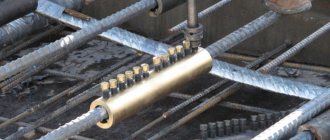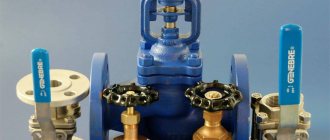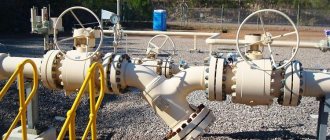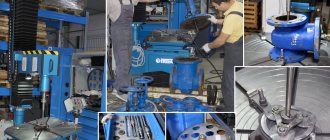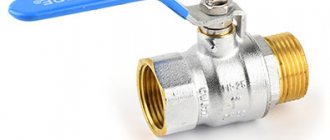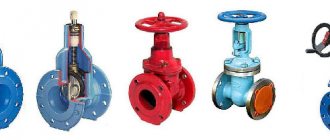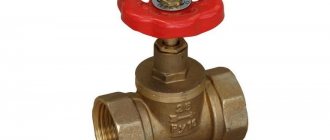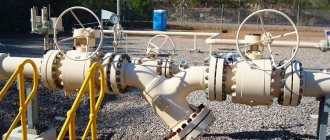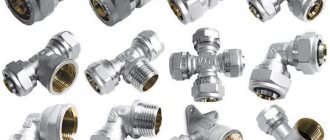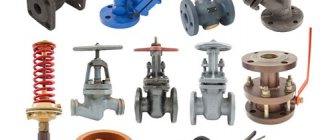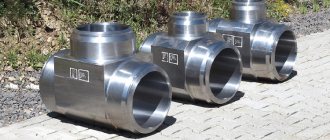All types of reinforcement connections can be divided into two large groups: detachable and permanent. A permanent connection (in most cases welding, sometimes soldering) is used where the tightness or other characteristics of other types of connections are not suitable for one reason or another.
The most common types of detachable connections of pipeline fittings include:
- Flanged;
- Coupling;
- Fitting.
Pipeline fittings flanged, coupling, pinned, union, welded
Pipeline fittings are classified according to different criteria ─ types, types, varieties*. One of the significant reasons for classification is the method of connecting fittings to a pipeline, container or equipment.
If the classification is based on the design of the parts responsible for connection, then the set of technical devices united by the term “pipeline fittings” will split into two large subsets with self-explanatory names - flanged pipeline fittings and wafer-type fittings. The strength and tightness of the first connection is ensured by the presence of flanges; the joining of the second is carried out without their help. The “squad” of wafer fittings includes coupling, pin-type, union fittings, welding fittings and some others.
When dividing pipeline fittings according to the method of connection, one can proceed from another characteristic: what kind of ─ detachable or permanent ─ connection is formed. In this case, almost alone (there is also a connection by soldering), the welding fittings form permanent connections. All other connections are detachable. A significant part of them ─ coupling, fitting, pin-type ─ are threaded.
Preparation of pipes
Branch pipes are elements of the valve body. Before welding them directly to the pipeline, the ends of the pipes are subjected to special mechanical processing (which depends on the type of weld): leveled, ground, chamfered. For example, the internal and external surfaces are cleaned to bare metal to a width of at least 20 mm from the edge cutting boundary. Particularly careful processing requires the connecting ends of pipeline fittings of large and extra-large diameters.
The preparation of welded fittings for welding should be carried out with the utmost care to prevent damage to the internal surface of the fittings as a result of contamination getting into it. To do this, use any available methods, plugs, fabric and other materials.
Quality control of edge preparation is carried out visually and using measuring instruments, including optical instruments, as well as through capillary and radiographic testing or ultrasonic flaw detection.
Flange connection of fittings
Connections using flanges are widely used in various areas of technology. Flange connections of pipelines and fittings have become widespread.
The word “flange” came into the Russian language from the German language along with the flange itself, and was not assigned on the basis of some analogies. In German, the noun Flansch means exactly the same thing as the Russian word “flange” derived from it, ─ a flat metal plate at the end of a pipe with holes for threaded fasteners (bolts or studs with nuts). It is more common when this plate is round, but the shape of the flanges is not limited to one disk. For example, square and triangular flanges are used. But round ones are easier to make, so the use of rectangular or triangular flanges can be justified for really good reasons.
The material, types and design features of the flanges are determined by the nominal diameter, pressure of the working medium and a number of other factors.
For the manufacture of pipeline valve flanges, gray and ductile cast iron and different types of steel are used.
Ductile iron flanges are designed to withstand higher pressures and a wider temperature range than flanges made from gray cast iron. Cast steel flanges are even more resistant to these factors. Welded steel flanges, while easily withstanding high temperatures, are inferior to cast flanges in the maximum permissible pressure.
Design features of flanges may include the presence of projections, chamfers, spikes, annular recesses, etc.
The prevalence of flanged connections for pipeline fittings is due to their many inherent advantages. The most obvious of them is the possibility of repeated installation and dismantling. The temptation to add the adjective “easy” to the noun “installation” is somewhat reduced if we remember how many bolts will need to be unscrewed and tightened when disassembling and joining flanges of large diameters (flange connections are usually used for pipe diameters of 50 mm or more). Although in this case, the complexity of installation work will not go beyond reasonable limits.
Flange connections are durable and reliable, which allows them to be used to complete pipeline systems operating under high pressure. Subject to certain conditions, flange connections provide very good tightness. To do this, the flanges being joined must have similar connecting dimensions that do not exceed the permissible error. Another condition is mandatory periodic tightening of joints, which allows maintaining the “grip” of bolted joints at the proper level. This is especially important when they are constantly exposed to mechanical vibrations or there are significant fluctuations in ambient temperature and humidity. And the larger the diameter of the pipeline, the more relevant this is, because as it increases, the force on the flanges increases. The tightness of flange connections largely depends on the sealing ability of the gaskets installed between the flanges.
Deformations cannot be discounted. Moreover, flanges made of different materials are susceptible to them to different degrees, therefore the material from which it is made is the most important parameter of the flange. Thus, ductile steel flanges are deformed more easily than those made of cast iron, which is more brittle but holds its shape much better.
The disadvantages of flanged fittings are a continuation of its advantages. High strength results in significant overall dimensions and weight, which, in turn, mean increased metal consumption (in the manufacture of large-sized flanges, it is necessary to use a thick metal sheet or round profiles of large diameter) and labor-intensive production.
How to cook
Before starting welding, technological preparation is carried out. Parts should be marked, cut, surfaces should be cleaned of dirt and rust and dried if moisture is present.
The two parts to be welded must lie on a flat surface and have a gap of 2-3 mm between them; we ignite the electrode with a blow or “strike” like a match, and perform two tacks to avoid deformation of the joint being welded.
Video
The video below shows what welding can lead to if you don’t use tacks (what you need to know about tacks here).
with lining (removable or remaining)
You can move the electrode towards yourself, away from you, from right to left and from left to right. Depending on the thickness of the metal and the recommended spatial position of the electrode, the method of moving the electrode for better welding is selected, and the electrode is also held at an angle of 45 degrees during operation.
After completing the seam, the slag is removed and the surface is cleaned. To avoid burns, use linings, with them the work is more confident, you can increase the current and not cook on the other side of the seam (see photo on the left).
Welding in the down position
The parts are cleaned; for thin metal, edge cutting is not performed; the gap between the parts to be welded is 1-3 mm. The assembly is carried out, the tacks are installed (after the tacks are cleaned), then welding is carried out on the back side of the tacks.
The thickness of the roller should not exceed 9 mm and the height 1.5 mm. We carry out welding from left to right, perform circular oscillatory movements counterclockwise, also weld the second side, on the second side you can increase the current, after welding we clean the surfaces.
butt joint with flange (for thin metal)
During the welding process, the electrode makes 2-3 movements.
- The electrode is lowered down as it melts, ensuring a stable burning of the welding arc.
- The electrode is moved at a uniform speed, tilting it at an angle of 15-30 degrees from the vertical. In the other plane, the electrode is perpendicular to the joint surface.
- If it is necessary to obtain a weld of increased width, various oscillatory movements are used.
Weld fittings
Welding of reinforcement is resorted to when the reliability and tightness of other types of connections is considered unsatisfactory. Welding is especially in demand when constructing pipeline systems in which the working environment is toxic, poisonous or radioactive liquids and gases. In this case, a welded connection, which, if properly executed, provides 100 percent tightness, may be the optimal, and often the only acceptable solution. It is only important that such a section of the system does not require frequent dismantling of equipment, the implementation of which will each time lead to complete destruction of the welded joints.
Thanks to welding, which combines fragments of a pipeline system into a single whole, it is possible to ensure harmony, or, in technical terms, structural compliance between all its elements - pipes and pipeline fittings. The main thing is that, due to differences in the mechanical properties of the welded joint and other components of the pipeline system, it does not become its weak link.
The connecting ends of the reinforcement are prepared for welding by leveling and grinding the surface of the welded fragments, removing the required chamfers.
Welded joints can be made in socket and butt. In the first case, the welding seam is located on the outside of the pipe. This option is usually used for steel fittings of relatively small diameter, installed in pipelines operating at high pressure and temperature of the working environment.
In the second case, the connection can be supplemented with a backing ring, which prevents distortion of the parts being connected. It is precisely these connections, characterized by reliability and absolute tightness, that are used when installing pipeline systems of hazardous production facilities, for example, power units of nuclear power plants.
Important advantages of welded connections, especially compared to flanged ones, are minimal weight, compactness and space saving.
How to buy shut-off control valves
We offer a favorable price for shut-off control valves of high quality and reliability. For many years, the organization has been cooperating with the best suppliers, offering the most modern components for pipeline systems at competitive prices. You will be able to select everything you need for heating, plumbing or other system equipment; both retail and wholesale orders are possible. GlavObject offers convenient terms of delivery and payment; you can purchase all the necessary equipment at competitive prices. The help of the company's experienced consultants will allow you to select the most suitable elements, contact us today!
Coupling fittings
One of the most common in technology is the coupling connection of reinforcement.
It is used for various types of valves of small and medium diameter, operating at low and medium pressures, the body of which is made of cast iron or non-ferrous alloys. If the pressure is high, then it is preferable to use pin fittings.
In the connecting pipes of coupling fittings, the thread is on the inside. As a rule, this is a pipe thread ─ inch thread with a fine pitch. It is formed in various ways - knurling, cutting, stamping. It is important that with a fine thread pitch, the height of the teeth does not depend on the diameter of the pipeline.
On the outside, the connecting ends are designed in the form of a hexagon to make it convenient to use the key.
The word “muff” came into Russian from German, and possibly from Dutch, where mouw means sleeve. The coupling, like the valve, is an example of how tailoring and the production of pipeline fittings each use in their special terminology words that sound the same, but carry different meanings. In engineering, a coupling is not a sleeve, but a short metal tube that provides connections to the cylindrical parts of machines.
The fine thread of the coupling connection plus the use of special viscous lubricants, flax strands or fluoroplastic sealing material (FUM tape) guarantee its high tightness. A coupling connection does not require the use of additional fasteners (for example, bolts or studs, as in a flange connection). But one cannot fail to take into account that screwing a coupling onto a thread with a seal requires considerable effort, the greater the larger the diameter of the pipeline.
How is it different from overlap
Welded lap joints are the fusion of different elements of a part located in parallel, partially overlapping each other. Used when butt jointing is not possible. An overlap connection is not recommended if the structure is subject to vibration; the steel thickness should be no more than 10-12 mm.
With butt it is important to take into account the accuracy of assembly , while with overlap assembly is much simpler and there is no need to cut the edges.
The disadvantage of an overlap joint will be the greater consumption of base metal, since one part covers another, corrosion of the metal may occur from moisture penetration between the parts, and it will not be easy to identify defects. In butt welding there is no overlap (overlapping) of parts; different welding techniques are used when welding overlap joints is performed using a fillet weld . In lap joints there is no need to cut the edges; there are also a large number of types of butt joints according to GOST.
Union fittings
The German origin of the term “fitting” from the verb stutzen (to trim, cut) even reveals its sound. This is the name given to the muskets used to arm armies up until the 19th century, due to the presence of a rifled barrel. In modern technology, this noun is used to define a short piece of pipe (in other words, a sleeve) with threads on both ends, used to connect pipes and pipeline fittings to units, installations and tanks. In a fitting connection, the connecting end of the valve with external thread is pulled to the pipeline using a union nut. It is used for fittings of small and ultra-small (with a nominal diameter of up to 5.0 mm) diameters. As a rule, this is laboratory or other special fittings. For example, reducers installed on compressed gas cylinders. Using a fitting connection, various control and measuring instruments (I&I) are “implanted” into pipeline networks, evaporators, thermostats, and many types of equipment that are part of chemical production lines are installed.
Clamp quick release connection (Tri-Clamp)
A modern quick-release connection for pipeline fittings, used mainly in the food industry, pharmacology and other industries where sterility and cleanliness are important. After all, this type of connection allows you to regularly remove, clean, and disinfect the equipment installed with this mount.
The clamp connection consists of two fittings, a seal and a clamp. The clamp presses the two fittings against the seal and against each other, resulting in a tight connection. We suggest you study what such a clamp is in the video.
The fittings are welded to the section of pipes where it is necessary to install pipeline fittings. Then just tighten the clamp and the equipment is secured. However, installing pipeline fittings with this type of connection is impractical if there is no need to regularly remove and reinstall taps or valves.

